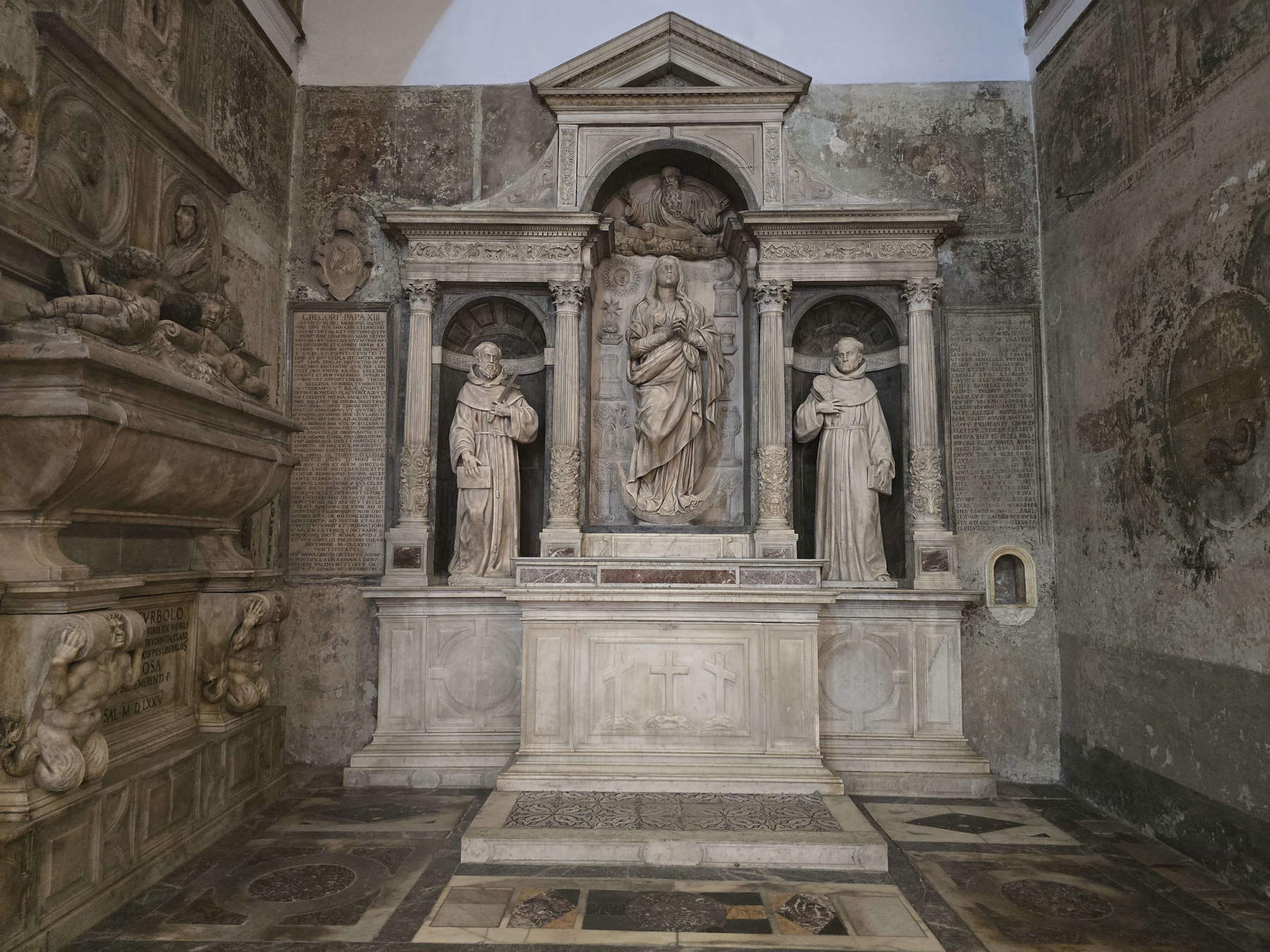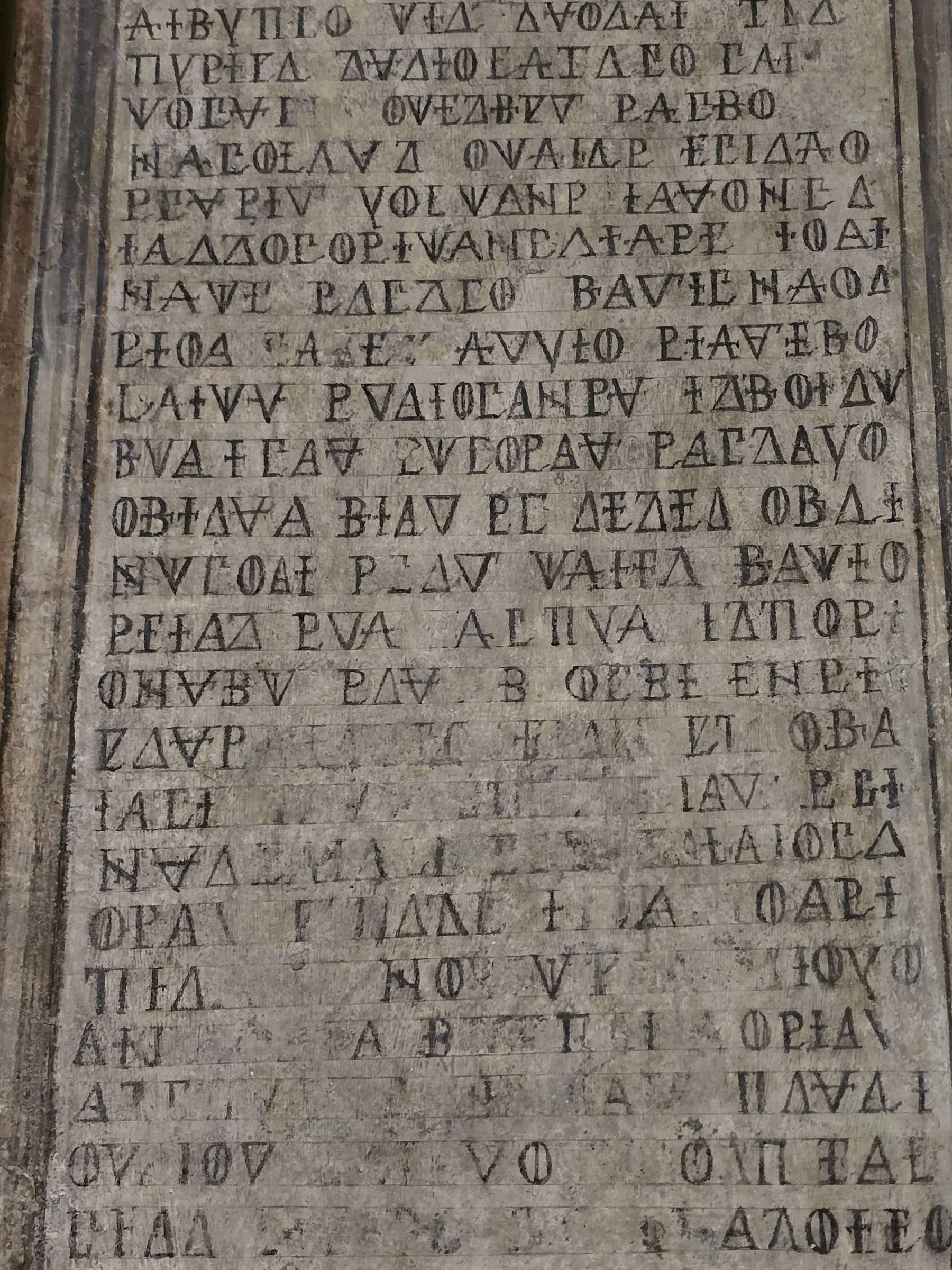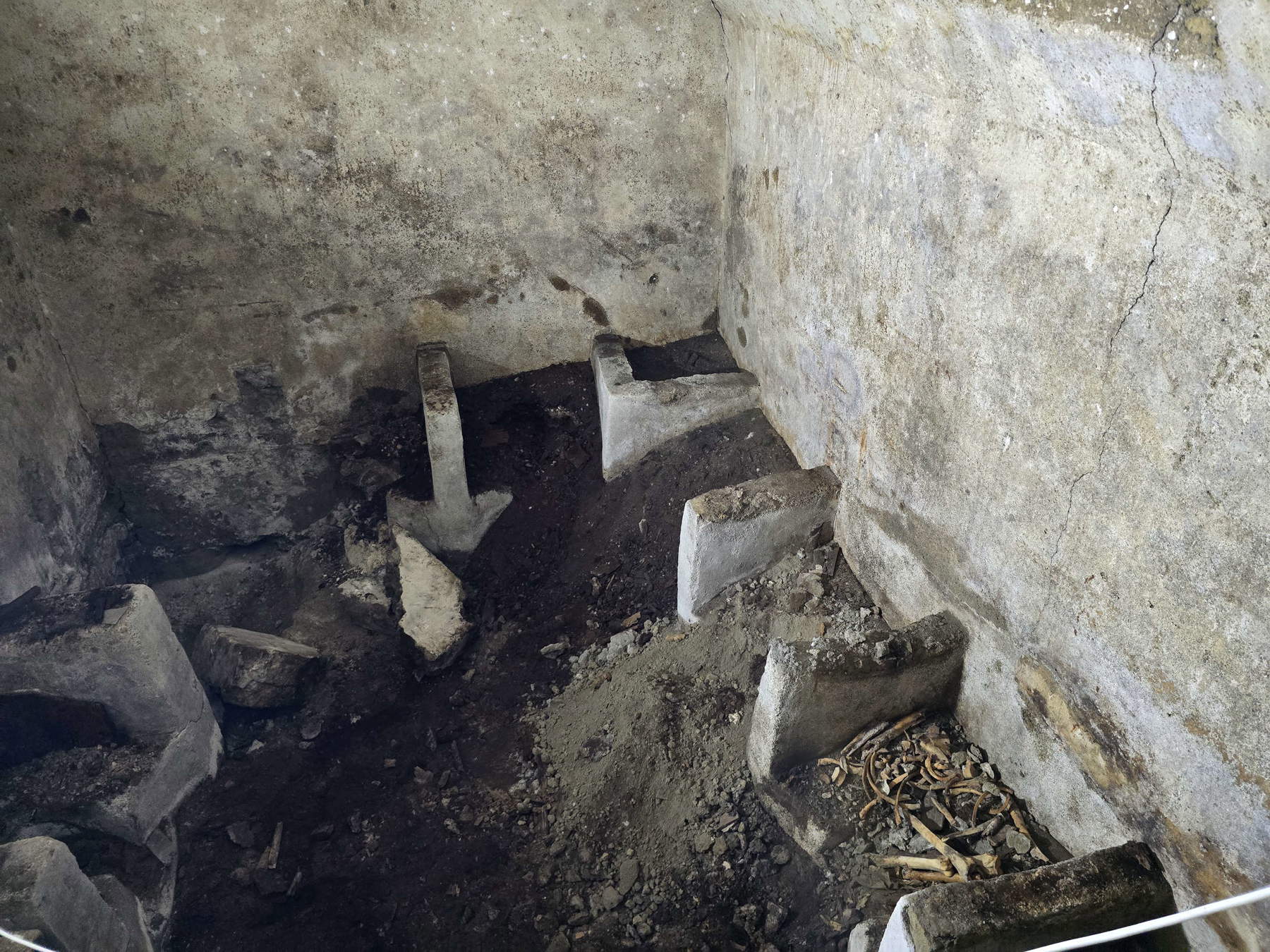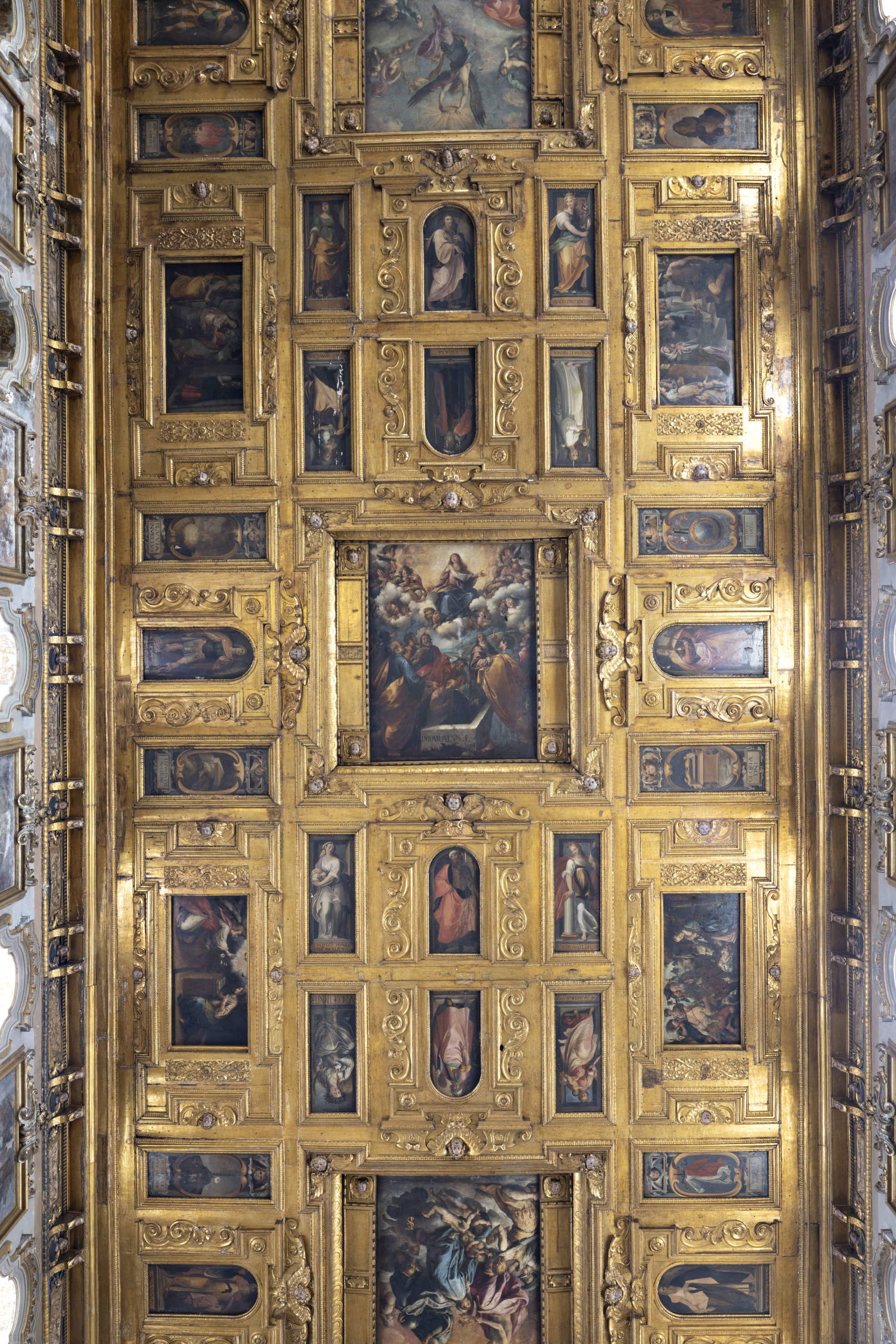In Naples, at the Santa Maria La Nova complex, a five-century-old mystery has attracted the attention of scholars (and the media as well): the possible burial of Vlad III of Wallachia, the prince whom legend turned into Dracula. The investigation is led by Giuseppe Reale, the complex’s director and consultant, who has been coordinating a group of researchers between archaeology, philology and the philosophy of memory for more than a decade. The study began with a 16th-century burial slab with a dragon, which suggested links to the Ferillo family and to Maria Balsa, possibly the daughter or granddaughter of the Wallachian voivod. In 2014 the La Nova Codex was discovered, an inscription interpreted as a possible eulogy to “Vlad the Pious.” Santa Maria La Nova thus also becomes a place of study and reflection on the mystery of history. Here the interview with the director offers an opportunity to learn more about the studies and research conducted within the complex.
NC. Director, in front of a slab that has been guarding its secret for five centuries, what does it mean today to declare that the burial of Vlad III, the prince whom myth later transformed into Dracula, might be in Naples?
GR. The slab of Matteo Ferillo’s funeral monument does not indicate the place of his burial. It is, rather, a symbolic element. Just in 2014, the image of the great dragon carved on this marble monument, placed in the cloister of St. James, gave rise to a path of investigation that stimulated new reflections and research. In any case, we have some certainties, acquired now for several years. Ferillo’s tomb, like others like it, was not originally located in the cloister, but inside the church. Indeed, a recently consulted document confirms that the Ferillo chapel was located on either side of the high altar, where it presumably remained until 1588. It is therefore necessary to distinguish the symbolic and imaginative dimension of the affair (which continues to exert great fascination), from the historical evidence that we are gradually consolidating. The burials of Santa Maria La Nova, as in many other churches until the early 19th century, were mostly located in underground burial chambers. Gentile chapels, mausoleums, and funerary monuments represented a figurative narrative for the faithful, while bodies were buried under the pavement according to various burial techniques. This is also true of Santa Maria La Nova, where this practice is now documented. In addition, the monument of Matteo Ferillo made it possible to draw important connections between the church of Santa Maria La Nova and the crypt of Giacomo Alfonso Ferillo and his wife Maria Balscia, located in Acerenza Cathedral. From here it was possible to develop broader connections between Naples, Acerenza and the territories of Wallachia, including through the study of other sepulchres. Among these, one of the most discussed is that of Constantine Castriota Skanderbeg, now also located in the cloister of St. James, but originally placed in the lower choir area. Monuments, therefore evoke presences and histories that historical research continues to interrogate. It is on this link of symbols, documents and hypotheses that a decade of study work has developed, aimed at reconstructing paths and relationships still shrouded in mystery.

When and how did the idea of scientifically investigating the burials and fragments you have analyzed come about?
Precisely from the geographical connections between the Kingdom of Naples, the Order of the Dragon and the Balkan Peninsula, we posed a series of questions. Questions that came together with the analysis of a rich symbology, typical of monuments that belong to a long historical-artistic tradition. A symbology that, for those living in different cultural contexts, requires complex and fascinating decoding work. During the first inspections, started in 2014, I observed some elements that deserved attention. I remember being struck by an inscription placed in a chapel adjacent to the Matteo Ferillo monument. I already knew that the tomb, however suggestive, was not located there: an inscription on the monument itself indicated that it was originally placed in the sacellum dedicated to the Virgin of the Assumption. I thus began researching possible placements and, in the course of doing so, came across another inscription in the Turbolo chapel, an aristocratic chapel located almost behind the current location of the Ferillo monument. Consulting the Guide to Santa Maria La Nova written in 1927 by Father Gaetano Rocco, a Franciscan, I found that he described that inscription as a “marble tombstone” that translated into Greek a Latin papal bull of Gregory XIII. The statement prompted me to reflect. First, the inscription was not marble at all, but painted; second, it was not an actual Greek text, but a sequence of discontinuous signs, not traceable to a single grammar or syntax. I then wondered why Father Gaetano had described it that way and why subsequent studies had merely repeated his interpretation without directly verifying it. A simple visual comparison with Gregory XIII’s papal bull of 1576 clearly showed the inconsistency: the Latin text of the bull was much more extensive than the lines on the chapel inscription. That observation made me sense that something more complex was hidden. Thus was born the idea of what we later called the “La Nova codex.” A curious aspect is that the inscription survived the many transformations of the large chapel dedicated to St. James of the Marches, within which the Turbolo chapel is located. In the late 15th century, in fact, the Spanish viceroy transformed a pre-existing church into a large worship and burial space dedicated to St. James, who died in 1476. Despite the subsequent changes, the inscription remained visible, although partially defaced and, as seen in the 2018 restoration, camouflaged in the frame as if it were a marble slab. After the restoration, I invited the engineer Falcucci to examine it, and although he did not belong to our study group, he initially speculated that it was a late 19th-century inscription. In any case, subsequent analysis led to different conclusions. There were no differences in mortar between the inscribed part, the frame and the surrounding frescoes, which can be dated to the beginning of the 16th century: this suggested a coeval realization. Moreover, examination of the pigments taken from the frame and letters showed that the color of the letters was two or three times thicker, a sign of an earlier dating than the nineteenth-century one originally assumed. It was therefore possible to backdate the inscription, placing it not in the 19th century but closer to 1575, the year of the Turbolo family burial. This made it possible to rule out any connection with the papal bull of 1576 and to recognize the La Nova codex as an autonomous, older document. In some places in the text the name “Vlad” clearly appeared, a circumstance that made the research even more interesting. I then invited linguistics experts from Eastern Europe to view the inscription. Each of them was able to recognize fragments, but none could give a complete reading. The narrative and symbolic potential of the figure of Dracula tends to obscure the historical complexity of Vlad III, the real character. Our goal was precisely to separate the legend from the historical fact, freeing Vlad III from the literary shadow of Dracula. In the following years, thanks to the confrontation with a team of Romanian scholars, the research took a quantum leap forward. Their contribution, rooted in their knowledge of national culture and symbolism, allowed us to transform our questions into more solid historical hypotheses, strengthening the connections between Naples, Wallachia and the Order of the Dragon.
The eulogy mentions a ruler, Vlad the Pious, who was “killed twice” and “honored as a martyr.” Can you elaborate on this? How does the mentioned concept strengthen the identification with Vlad III compared to other possible figures of the time?
Surrounding the attempt to decipher the inscription has been the focus of numerous scholars over the course of ten years. It all started with an international call in 2014: an open discussion from which a curious fact emerged, namely that no one could recognize in that text the features of a known language. It did not belong to any classical language or to the “archaeological” ones that pass on the memory of ancient civilizations. The work, therefore, proceeded by exclusion rather than affirmation. Young researchers were also involved at that stage, experimenting with computer decoding techniques. The idea in truth was not new: in those same years an Italian researcher in the United States had used similar systems to decipher an ancient Aragonese text. So we were moving in the same direction, looking for a method that could reveal the hidden meaning of that code. A turning point came with the collaboration of Mircea Cosma, head of the Historical Society in Ploiești, Romania. Mircea was working together with Christian Tufan, an expert on Byzantine Greek, and already in the first exchanges Cosma had anticipated to me some reading hypotheses, albeit still fragmentary. The real turning point came on June 28, 2025, during a meeting in Snagov, one of the places traditionally associated with the figure of Vlad III. On that occasion, Tufan publicly presented a proposal for a complete interpretation of the inscription, accompanied by a transliteration into Greek and a translation into Romanian, which I later translated into Italian. He is the one who signed and took scientific responsibility for the reading, which we published in the volume Vlad, where are you? Clues from the La Nova Codex of Naples, published by La Valle del Tempo. The book collects the interventions of all participants in the project and documents the long research that culminated in this interpretive proposal. According to Christian Tufan, the inscription is built on three overlapping linguistic levels. The level of full meaning, the one below, is in Byzantine Greek and returns a text of surprising coherence: it is a eulogy ending with an invocation. Within it appear explicit references to Vlad, referred to as the Prince of Wallachs," but not identified as Vlad Țepeș, the impaler, but as Vlad the Pious, “he who died twice.” The formula thus carries special weight: on the one hand, it evokes the veneration reserved for a martyr; on the other, it alludes to a double death, suggesting that the traditional dates, December 1476 or January 1477, should be overcome. It is a well-known fact that Vlad III’s remains have never been found. The two Romanian tombs at Snagov and Comana, both attributed to him, have returned no human remains traceable to the voivode. As historian Carmen Bejanaru recalls in the volume, Snagov’s tomb was opened in 1933 and contained only horse bones; the same result was found at Comana, a monastery he founded. Today our research group is engaged in further investigations, including a mission to Istanbul, where we expect to consult documents related to Ottoman military campaigns. No archives, so far, attest to the existence of Vlad’s alleged scalp, which tradition says was given to the sultan as a war trophy. Reinforcing the hypothesis of survival beyond 1477, Mircea Cosma found a letter, published in the Romanian Annals, in which a citizen of Krems, near Vienna, reports seeing Vlad in 1477, still leading an army. The inscription in Santa Maria La Nova also gives a precise date of death: November 20, 1480. This is an important date because it coincides with the period of the siege of Otranto, which began on August 14 of that same year and ended with the massacre of the 800 martyrs who refused to abjure the Christian faith. On September 16, 1480, Pope Sixtus IV and the king of Naples called for a military league to repel the Turkish invasion. I believe there are direct connections between the Otranto campaign and Vlad III’s presence in the Kingdom of Naples. This was the starting point of our 2014 study of the relationship between Giacomo Alfonso Ferillo, son of Matteo, and his bride Maria Balscia, who are buried in Acerenza, where the crypt is decorated with dragon motifs. Those very dragons, symbols of the Order of the Dragon, represent the thread connecting Vlad, the Ferillo family and the church of Santa Maria La Nova. The inscription, interpreted today in light of these connections, suggests that Vlad died in the Kingdom of Naples, in a context of battle, “killed twice by his enemies,” as the text reads. Reinforcing the hypothesis of a burial in Santa Maria La Nova are two additional artistic clues. The first concerns the presence, at the foot of the altar, of Joan III of Trastámara, a military lieutenant engaged alongside her husband and later stepson, buried there in 1518. The second clue is symbolic in nature: in the same church rests Hamida, son of the last ruler of Tunis, who was taken prisoner and later converted to Christianity under the spiritual guidance of John of Austria, the commander of the Holy League that defeated the Turks at Lepanto in 1571. The great wooden ceiling of the nave, with its forty-seven late 16th-century canvases dedicated to the Virgin of the Assumption, was precisely financed by this converted Islamic family. It is revealing that the pictorial cycle pays homage to the role of women in salvation history and, at the same time, to the Christian victory over Islam, symbolized by an inverted crescent in the coat of arms of John of Austria. As if Santa Maria La Nova had taken on, over the centuries, the function of a pantheon of militant Christianity, custodian of the memories of sovereigns, leaders and dynasties united by a common thread: the struggle against Ottoman expansion. In this perspective, the presence of Vlad III, a knight of the Order of the Dragon and a prince committed to the defense of Christian Europe, finds full meaning. The Neapolitan church is thus presented as the final piece in a narrative that links Otranto and Lepanto, 1480 and 1571, in a long story of faith, war and memory.


One element I find interesting is the dating between 1480 and 1490, linked to the figure of Maria Balsa, believed to be Vlad’s daughter or granddaughter. What importance did the female presence in Naples have in the reconstruction of the historical picture?
Maria Balsa is configured as a figure who moves on two temporal levels. The first concerns her connection with Giacomo Alfonso Ferillo, evidenced by the Acerenza crypt. In this dimension, art takes on a cognitive function and here aesthetics becomes a means of understanding. The crypt, with its Draculian-esque symbolism, raises definite questions: was Maria an Albanian noblewoman according to some Balsic, or did she come from a principality we would identify today as Romanian? In all this, Maria Balsa served as a bridge between the persecution-scarred Balkan peninsula and southern Italy, particularly Acerenza and Naples, where she arrived through marriage to Giacomo Alfonso Ferillo. Their two daughters, Beatrice and Isabella, then fit as additional pieces in this historical reconstruction, making it even more important. Subsequently, research has sought to clarify her role through a 16th-century chronicle, although there are several alternative interpretations. According to one reading, Maria would have been brought to Naples by Constantine Castriota Skanderbeg, future bishop of Isernia, who is also buried in Santa Maria la Nova. An enigmatic inscription appears in the funerary monument dedicated to him by Andronica Comnenus: “Maria,” without any reference to Santa Maria. The evidence thus raised puzzles. How could an orphan who had arrived in Naples under Skanderbeg’s tutelage have been received into the Ferillo court and then married James Alfonso Ferillo? The initial hypothesis considered the possibility that Maria had brought her father’s remains with her, but today the interpretation of the inscription allows for an independent understanding of these movements, considering the migrations independently of the places of contact. While the connection with Santa Maria la Nova, where the graves of the Ferillos and Constantine Castriota Skanderbeg are located, remains evident, historical affinities emerge that paint an interesting and complex picture. Current research focuses on Maria Balsa’s noble origin: fellow Romanian historians are acquiring documents that delve into both the Acerenza crypt and the territories of present-day Romania, trying to clarify precisely Maria Balsa’s origins.
What does it mean for Naples to be able to display an epigraphic document about Vlad the Impaler that is as explicit as it is relevant?
Naples remains a capital even today. It is a capital of junctions and crossroads, a crossroads where different realities meet and intertwine. The very fact that a codex could survive itself, at a time when great basilicas and cathedrals were being torn down to make others, demonstrates the city’s distinctiveness. At that time there was no science of preservation such as we have developed in more recent times. A relevant example is the Greek inscription preserved in Naples: although codified, it remains a natively Greek sign, a witness to the city’s ability to keep different worlds and cultures together, hybridizing rather than suppressing them. The very grammar of Naples, as layered as its history, shows this aptitude: connecting rather than excluding, connecting rather than colonizing. The city has also exercised function as a refuge. The presence of Muslims housed in the Jewish quarter and fleeing nobles confirms this inclusive capacity. Naples shows, in its contradictions and stratifications, not only the traces of a long and complex history, as is the case in many capitals, but also a vocation for encounter and coexistence. Santa Maria L’Aquila is a concrete example: it preserves works from the Neapolitan Renaissance alongside masterpieces from the Baroque period, perfectly embodying the city’s cultural and historical stratification.
Santa Maria La Nova is a place that preserves works from the Neapolitan Renaissance and Baroque periods. What tourist impact do you imagine the new interpretation of the slab will have, and has it already had in these summer months?
When dealing with issues like these, it is crucial to distinguish the cultural focus from the tourism offer. The tourism debate has specific meanings, and I don’t think the Louvre should apologize for visitors going to see the Mona Lisa. It is true that well-known works can overshadow other creations, but this happens routinely. The main difference lies in time and approach. Tourism is often measured in quantity, in short, hurried visits, while culture requires attention, contemplation and sedimentation. Walking through a large museum it happens that one remembers little of what one has seen: the ability to stop and delve deeper is what distinguishes the cultural experience from the tourist experience. At the same time, the themes present great communicative potential. Take Vlad III of Wallachia for example: many visitors to Santa Maria la Nova arrive interested in the myth of Dracula. Analyzing the figure’s immortal fascination means questioning the transposition of evil: as a symbol, Dracula combines cruelty and fascination, and his narrative fortune, from Gothic novels to Twilight, shows how evil can be represented in a secularized form, allowing us to explore the darker instincts present in each of us. The historical interest in Vlad III thus has an explanation, but its communicative impact goes beyond that. Although visitors arrive attracted to the myth, they often leave with a broader understanding, entering into the art of the late 16th century and 17th-century pictorial evolution in Naples. Santa Maria la Nova is one example: incorporating the Mastria Tower and the city’s ancient western walls, it holds stories and works ranging from the Renaissance to Neapolitan Baroque. The story of Michelangelo Merisi also fits into this framework. During his sojourns in Naples, he stayed at the Inn of the Cerriglio, at the foot of the defensive tower, and suffered an attack that nearly killed him. In the context of the ceiling of Santa Maria la Nova, completed in 1609, and his relations with Battistello Caracciolo, Caravaggio encountered a city in which realistic innovation married visions of human frailty and cruelty, outlining the pictorial revolution that Naples helped develop. It is therefore important to hold together, without confusing them, the tourist experience and cultural insight. Tourism traverses, distributes interest, but cultural attention stops, observes and understands.
Following the discovery of the inscriptions, have cultural exchanges and collaborations with entities, museums or foundations in Romania already arisen or are they expected to arise in order to strengthen the historical link between Naples and Vlad III’s homeland?
With Romania there are exchanges of great friendship and cultural collaboration. I had not deepened the ties until I received an invitation from Mircea Cosma to give a lecture in Romania. On the issues I feel very calm, because the reconstructive hypotheses I advance are based in particular on the studies of two Romanian historians, including Cristian Tufan. The fact that local scholars support these theses with seriousness and rigor is very important: for us Vlad III is a historical figure to be rediscovered among the many that characterize the Italy of a thousand faces, while for Romania he represents a leading national figure. I am therefore deeply grateful and admired for their intellectual honesty. The path of research they have undertaken provokes discussion even within their own territory and has received wide resonance in the media and on Romanian television. Vlad III, for them is part of a rediscovery of historical and cultural roots that many Eastern European countries, freed from the experience of real socialism after the fall of the Berlin Wall, are pursuing as a central element of their national identity. That Romania considers and places on the agenda historical investigations of this kind represents a strong ability to rewrite and reinterpret its own history with rigor and awareness.


In your opinion, how can the difference between the documented artistic reality and the Gothic legend of Dracula be communicated to the general public without trivializing the discovery?
It is not a simple question. This summer, at the end of June, I was still in Snagov and Comana when I asked my colleagues to engage in the publication of the paper. The goal was to provide in-depth tools, creating a reference platform and taking responsibility for our theses. The work tied in with other contributions, such as Susi Bladi’s text and a documentary broadcast on La7 (also available in rewind mode). In these productions, Bladi accompanied us in our search for Vlad’s tomb, integrating in the latest editions chapters that take up and deepen our hypotheses. In summary, we have produced two printed instruments and one video, presenting an in-depth historical-scientific, popular mediation and a documentary perspective that is also accessible to non-specialists. Once a month we organize free guided tours of Santa Maria la Nova, during which I answer visitors’ questions, from the most common to the most articulate. I collaborate with tour guide associations for in-depth moments, and I often stop by to talk to people who are experts or simply curious, giving details that go beyond just sightseeing. We are aware of the dissemination potential of our approach. Studying and communicating allows us to better understand how to pursue historical research and, at the same time, to offer tools of understanding to the public. As an example, a video made this week by a well-known Neapolitan tiktoker reached nearly 600,000 views in a few hours, demonstrating enormous dissemination potential. This kind of work is a delicate but crucial educational task. Through it one can build a true discovery of Neapolitan history, combining historical rigor and communicative appeal. I experience it as an opportunity to do schooling, combining research and cultural mediation.
Warning: the translation into English of the original Italian article was created using automatic tools. We undertake to review all articles, but we do not guarantee the total absence of inaccuracies in the translation due to the program. You can find the original by clicking on the ITA button. If you find any mistake,please contact us.